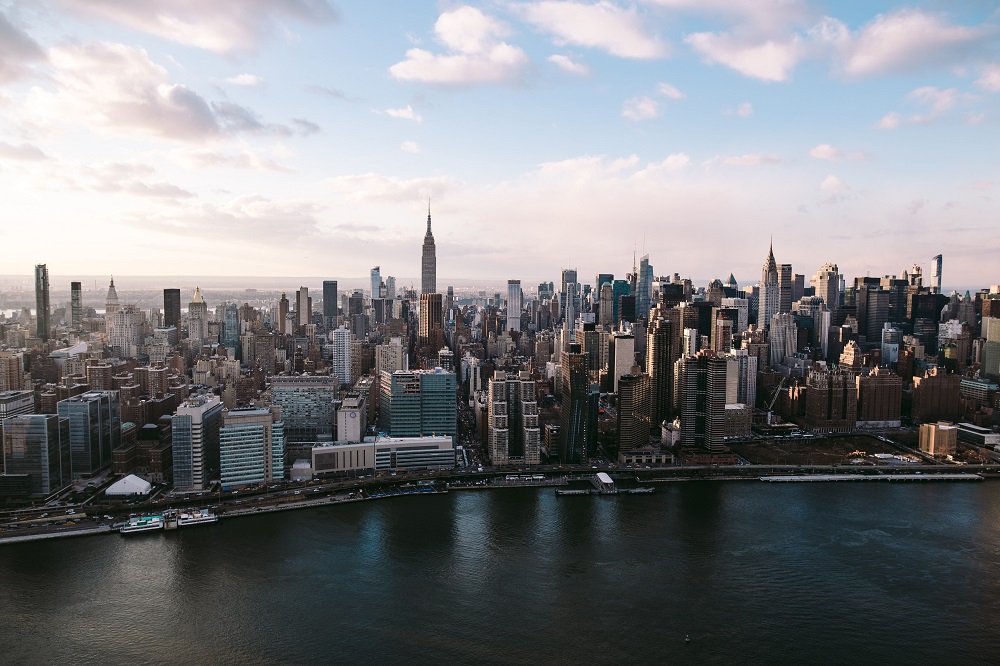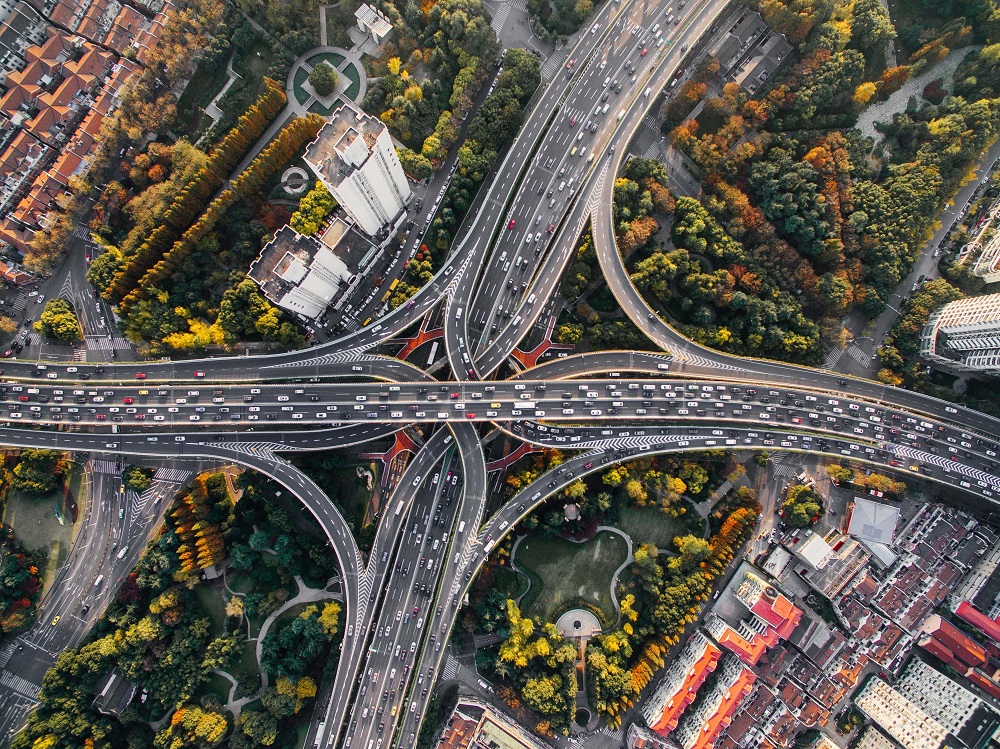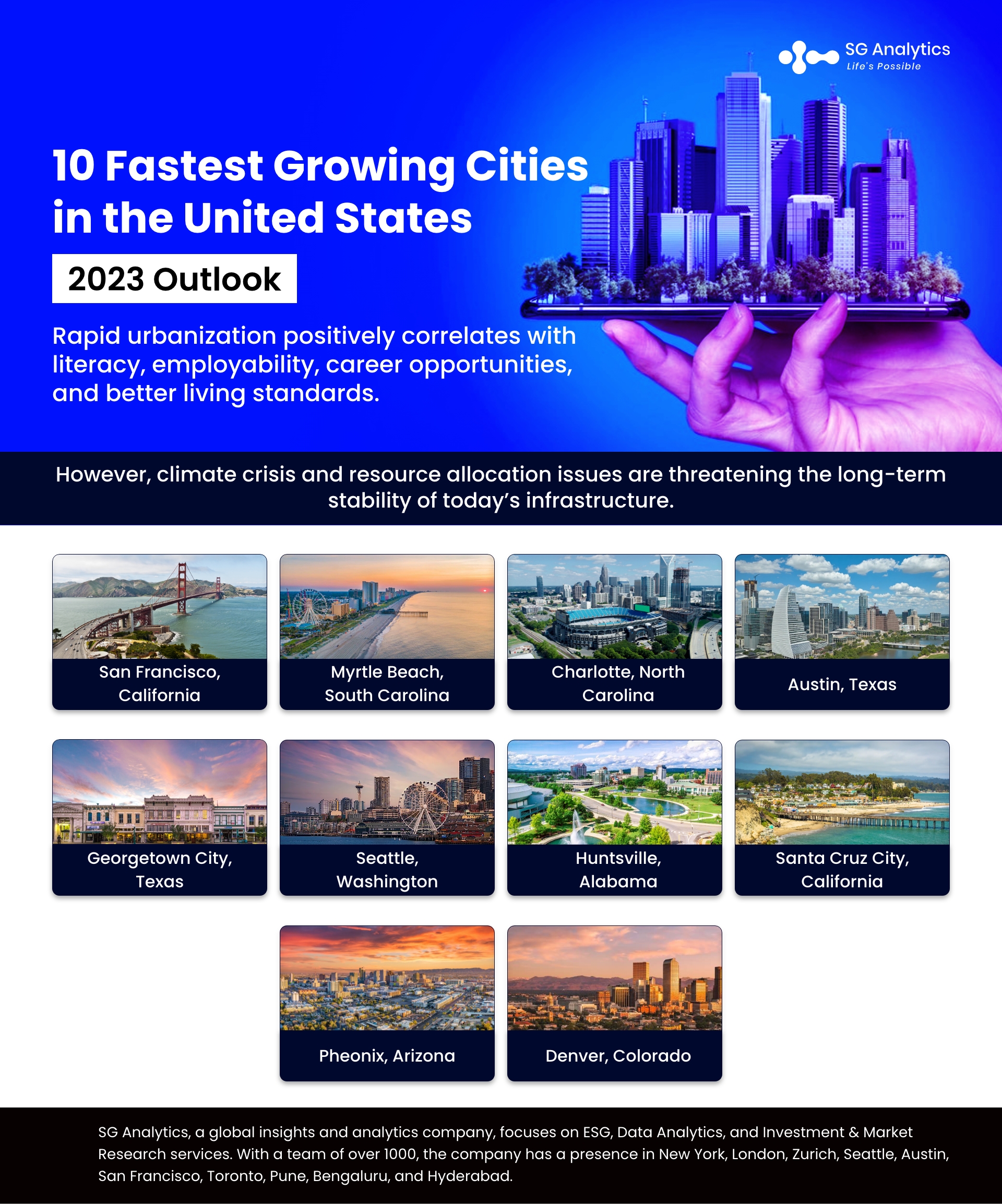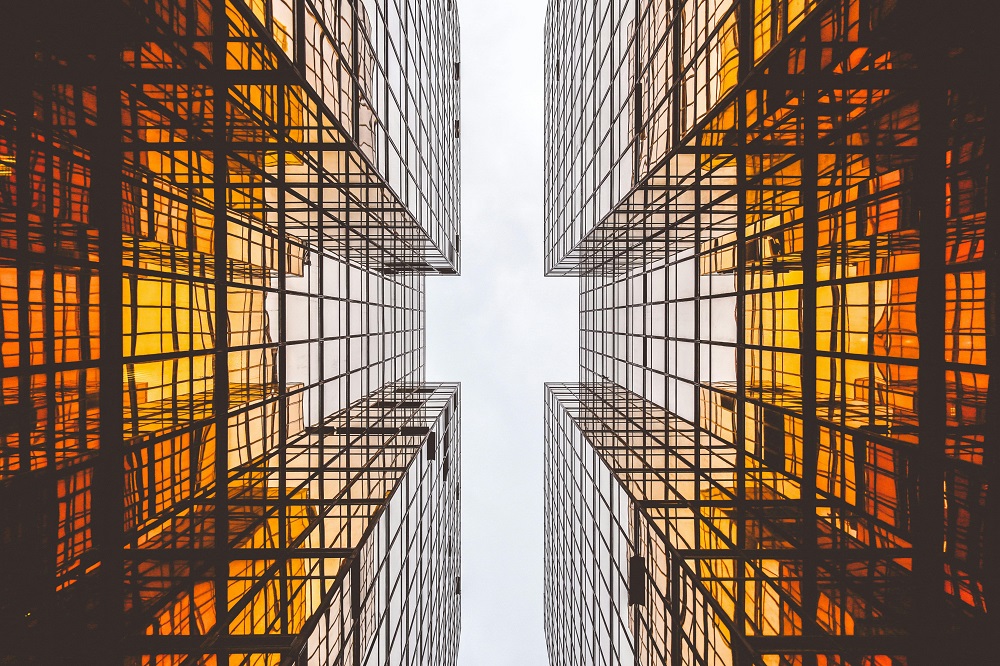Rapid urbanization positively correlates with literacy, employability, career opportunities, and better living standards. However, responsible town planners recognize the significance of reducing haphazard growth risks like deforestation and inefficient transportation. Likewise, studying how other cities and municipalities have addressed the challenges in urban development can inspire everyone. This post describes the top 10 fastest-growing cities in the US.
Definition of Growth Factors
Quantifying urban growth relies on population, technology, industrialization, advanced educational facilities, comprehensive healthcare infrastructure, sanitation, and efficient transportation. Depending on the researchers, these components can have more granular metrics focused on specific functions like sewer and pipeline management.
The urban development metrics focus on a greater population requiring more sophisticated systems. Besides, most sustainable companies prefer operating in the fastest-growing cities in the US to leverage advanced infrastructure and serve a lot of customers without distant transportation needs.
Simultaneously, talented professionals settle in such urban areas to explore more distinct job roles otherwise unavailable in remote or rural regions. They contribute to a city’s cultural and economic prosperity. However, poor literacy increases slum zone formation risks. As a result, defining urban growth emphasizes city dwellers’ technical competencies.
Importance of Analyzing Fast-Growing Cities
According to the World Bank’s estimates, 80% of the world’s gross domestic product (GDP) has urban origins. Moreover, 6 billion individuals will belong to cities by 2045. So, municipal corporations must prepare strategies to accommodate the continuously increasing urban population’s requirements.
At the same time, climate crisis and resource allocation issues threaten the long-term stability of today’s infrastructure. Solving these puzzles at a global scale is slow, suffering from policy-to-implementation delays. Nevertheless, if cities are the epicenter of population density and extensive resource consumption, making them more sustainable must significantly assist in the world’s energy transition and carbon risk mitigation.
Aside from population management and sustainable development, innovation is the third reason why urban growth data analysis is crucial. You want to gather high-quality data describing problematic events and examine the insights for practical solutions. The queries can be identical to the following examples.
-
How can local bodies reduce homelessness and slum zones?
-
What will make transportation faster and safer for citizens?
-
How do other cities with similar growth metrics manage their population and infrastructure?
Top 10 Fastest Growing Cities in the US
89% of the US population will live in cities by 2050. While New York, Los Angeles, and Chicago are growing fast, Houston, Phoenix, and Philadelphia have a remarkable population to serve. Meanwhile, Sarasota and Fort Myers are not to be forgotten.
Developed countries, like the USA, often exhibit more urbanized regions. So, easily connect with the nearest trade centers thanks to the straightforward paths between the docks, airports, and railways. Additionally, responsible and sustainable urban planning prevents these fastest-growing cities in America from becoming the most polluted cities in the USA.
You can determine the difference between their growth through multiple metrics. For instance, assessing public transportation quality and private vehicle usage can help estimate the effectiveness of planned roads and railway tracks.

Are the citizens happy with their city’s infrastructure? How much time is wasted or saved when they select public transportation instead of private vehicles? Similar queries help architects, engineers, policymakers, and businesses optimize present infrastructure to increase the quality of life for all.
Fastest Growing Cities Rankings
1| San Francisco, California
Technology giants and their new interns occupy San Francisco while having contributed to 5.5% of the US GDP in 2022. This Silicon Valley in the Bay Area extends to Palo Alto, Mountain View, Cupertino, San Mateo, and Santa Clara. Amid the massive tech layoffs and recruitment pauses, San Francisco continues to create valuable innovations and attract talent from all over the world.
2| Myrtle Beach, South Carolina
In terms of fast urban growth, this tourism-friendly zone belongs to the top three cities. According to real estate agents, individuals who prefer outdoor recreational exploration arrive in Myrtle Beach. Its 60-mile seashore accommodates beach lovers’ interests. Besides fishing and boating, residents spend time at locally owned restaurants and golf courses. It is one of the fastest-growing cities in the United States because of the low cost of living and natural beauty.
3| Charlotte, North Carolina
Bank of America and Truist Financial are some of the economically significant employers in this populous city in North Carolina, alongside Wells Fargo. Charlotte has witnessed a construction boom dating back to 1982. While Hearst Corporation and Duke Energy are essential to the local community, several hotel businesses serve Charlotte’s ever-changing population dynamics. This city has headquarters or eastern operations units of 7 companies belonging to Fortune 500.
4| Austin, Texas
Austin provides residents access to several art museums and higher education opportunities. Its live music events and Lady Bird Lake kayaks attract people from many remote places. This city’s McKinney Falls State Park offers swimming, hiking, and camping. In 2021, the Austine metropolitan area witnessed various companies relocating there, creating many job roles and attracting more people. It also ranked 10 in the US Census Bureau’s populous cities estimate from May 2023.
5| Georgetown City, Texas
In terms of year-on-year percentage increase, no city beats Georgetown. Its population grew by 14.4% between 1 July 2021 and 1 July 2022. Victorian architecture for commercial as well as residential structures differentiates Georgetown from other cities. Southwestern University and the Sun City Texas project explain why this town ranks among the fastest-growing American cities.
6| Seattle, Washington
Seattle’s metropolitan area is at the fifteenth spot among the largest cities based on population. When Amazon moved its headquarters to South Lake Union, Seattle’s unemployment rate declined to 3.6%, making it attractive to real estate developers and job seekers. Despite less rainfall and multiple earthquakes, Seattle has thrived. Its performing art center and cruise industry keep attracting more tourists and residents.
7| Huntsville, Alabama
The US Army and NASA have a remarkable presence in Huntsville, Alabama, which houses many engineers, scientists, and defense officers. Exploring the Huntsville Museum of Art and the North Alabama Railroad Museum are activities loved by the residents and tourists. However, space and engineering remain integral at the US Space and Rocket Center. Meta, Toyota, Cummings Research Park, and ADTRAN have created career opportunities for the locals.

8| Santa Cruz City, California
The city of Santa Cruz grew by 12.5% year-on-year, getting the second place in the fastest-growing large cities in the US after Georgetown. Its surf culture allows tourists to interact with the true might of the ocean. Agriculture, education, and advanced technology are other industries helping Santa Cruz city’s growth. This city has a surfing museum focused on art and natural history. Besides, the University of California and several private schools enhance the academic development of aspirants from many regions.
9| Phoenix, Arizona
Motorola made Phoenix into its research and development (R&D) center for electronics innovation to help the military. Later, Intel came to Phoenix and created new jobs. Although Pheonix had hot weather conditions, improved air conditioning technologies enhanced living comfort. The city has many nodes or urban villages facilitating easier freeway transport. These areas permit additional height for construction works if an enterprise requires this flexibility.
10| Denver, Colorado
This “Mile High City” is almost 1 mile above sea level and equidistant from Chicago, Los Angeles, St. Louis, and San Francisco. Therefore, its transportation is indispensable for goods and services moving between the fastest-growing cities in America. Enterprises like United Airlines and Xcel Energy offer career growth opportunities in Denver. Also, the neighboring Rocky Mountains have attracted mining specialists for decades. So, Chevron Corporation and similar firms have a presence in Denver.
Common Trends Among Fast-Growing Cities
Urbanization accelerates individual productivity and reshapes the cultural dynamics in a region. This impact extends to promoting sustainability accounting practices and launching affirmative action campaigns for discriminated and poor people without housing.
Since 2020, public healthcare has also become more significant to urban planning.
The competitive world demands tech-literate professionals. So, addressing the digital divide between communities and age groups is essential in all the fastest-growing cities in the United States. Simultaneously, municipalities have tested advanced surveillance and crowd management technologies to maintain law and order.
All urban areas, whether growing rapidly or slowly, want to attract global corporations to increase employment and create opportunities for the youth to learn more rewarding skills. Therefore, city councils or metropolitan development bodies sign memorandums of understanding (MoUs) with universities, independent agencies, and private companies.
Future Prospects for the Fastest-Growing Cities in the US
1| Mixed-Use Areas
Reducing carbon emissions requires decreasing transportation activities. When developers create a mixed-use environment, they introduce lifestyle-related services. So, the residential communities become more self-reliant as all the standard grocery and hardware stores are within walking distance.
Urban planning professionals can create these hybrid structures serving residential, academic, commercial, cultural, clinical, and recreational interests. They will eliminate the need for frequent travel between places, make residents walk more, and encourage in-person socializing.

2| Energy-Efficient Development
Constructing a building involves extensive water, electricity, and petroleum consumption. However, better technology, regular machine maintenance, and research effort can pave the way for less resource-heavy processes.
The savings can go to a green fund to facilitate green tech integration across buildings. Moreover, the reduced carbon footprint will let residents and developers lead a more sustainable living. Municipalities must formulate standard guidelines to promote these approaches.
3| Affordable Housing
Ghost towns become a reality when many flats have no takers. Improper debt management and salary hikes lagging in increased living costs exacerbate this issue. At the same time, several individuals become homeless every year.
Owners are willing to rent out or sell their empty houses, and people desperately want to occupy them. Still, financial hurdles prevent both sides from closing the deal and moving on in life. Affordable housing employs innovation and maximizes material efficiency.
Therefore, individuals belonging to the low-income group (LIG) can get homes with reasonable structural stability and durability. This approach will also empower the fastest-growing industries in the US to create less costly living spaces for their field workers. In short, slum zone formation will decrease.
Challenges Faced by Fast-Growing Cities
1| Resource Constraint and Population Forecasting Accuracy
More citizens need more housing, water pipelines, sewers, waste disposal, electricity, health services, schools, retail stores, and transportation. Nevertheless, the municipal corporations might tap into taxpayers’ contributions and realize they lack the funds to build the required infrastructure.
Preventing such events demands data-backed population forecasting methods. Otherwise, mayors and urban planners will create long-term facilities, expecting the population to increase by 10,000. But the actual population might grow faster, increasing strain on the infrastructure.
2| Affordability and Homelessness
Expensive housing will alienate citizens. However, ensuring structural safety using good quality materials leads to inevitable price hikes. Likewise, municipalities might delay crucial maintenance and retrofitting tasks if they lack the financial resources.
The affordability challenge can undermine the vision of the fastest-growing cities in America. Therefore, leaders must address this situation without creating economic hazards. Cooperative housing and shared spaces can temporarily alleviate home unaffordability and homelessness. However, lasting solutions include increasing the employability of the people who struggle to own or rent a flat through skill development.

3| Corruption and Haphazard Growth
Illegal constructions increase when corruption is rampant at a municipal organization. Since a well-maintained building can last 30 to 50 years, demolishing it is still expensive and a waste of time and resources.
Depending on where you live, if occupants have already lived in the unregistered structure for a long time, ethical and controversial aspects can discourage authorities from eradicating illegal buildings. That can happen again, leading to the haphazard growth problem.
Haphazard urban growth lacks geometric, commercial, and aesthetic sense. It can destroy green belts around cities. This unregulated urban expansion relies on officials and neighboring property owners ignoring, underestimating, or even encouraging land encroachment. It can affect roads, sewers, and future master plans. Unplanned growth can turn a town into one of the most congested cities in the US.
Read Also – World’s Most Congested Cities After Pandemic
Conclusion
Urbanization has increased since industrialization offers individuals more diverse opportunities to grow professionally, intellectually, and creatively. Consider a child in a remote region dreaming of becoming an excellent 3D animator or advanced statistics specialist. Accomplishing these ambitions needs appropriate guidance, learning-teaching facilities, and financial feasibility.
Cities provide the mechanism needed to find better lifestyles, careers, and services. The fastest-growing cities offer many times more interactive and competitive environments. They have helped modernize agricultural sectors, automate manufacturing tasks, and create immeasurable service sector jobs.
Each of these evolutions demanded extensive capital resources, multidisciplinary teams, and robust infrastructure. Today, people flock to cities seeking a chance at an improved life. However, sustainability and governance challenges threaten urban development. All stakeholders must utilize appropriate strategies and technologies to overcome those issues and let the cities grow responsibly.
SG Analytics, recognized by the Financial Times as one of APAC's fastest-growing firms, is a prominent insights and analytics company specializing in data-centric research and contextual analytics. Operating globally across the US, UK, Poland, Switzerland, and India, we expertly guide data from inception to transform it into invaluable insights using our knowledge-driven ecosystem, results-focused solutions, and advanced technology platform. Our distinguished clientele, including Fortune 500 giants, attests to our mastery of harnessing data with purpose, merging content and context to overcome business challenges. With our Brand Promise of "Life's Possible," we consistently deliver enduring value, ensuring the utmost client delight.
A leader in Market research services, SG Analytics enables organizations to achieve actionable insights into products, technology, customers, competition, and the marketplace to make insight-driven decisions. Contact us today if you are an enterprise looking to make critical data-driven decisions to prompt accelerated growth and breakthrough performance.

About SG Analytics
SG Analytics is an industry-leading global insights and analytics firm providing data-centric research and contextual analytics services to its clients, including Fortune 500 companies, across BFSI, Technology, Media and entertainment, and Healthcare sectors. Established in 2007, SG Analytics is a Great Place to Work® (GPTW) certified company and has a team of over 1100 employees and a presence across the U.S.A., the U.K., Switzerland, Canada, and India.
Apart from being recognized by reputed firms such as Analytics India Magazine, Everest Group, and ISG, SG Analytics has been recently awarded as the top ESG consultancy of the year 2022 and Idea Awards 2023 by Entrepreneur India in the “Best Use of Data” category.
Frequently Asked Questions (FAQs)
A. What defines a city as ‘Fast-Growing’?
Answer: A fast-growing city will remarkably increase its population in a specified timeframe. Data concerned with whether one city grows faster than another will vary according to other assessment metrics.
Cities’ rank can change after considering GDP, literacy rate, sustainability compliance, and renewable vs. non-renewable energy consumption. Therefore, you want to develop a standardized method to quantify or benchmark the urban development in the fastest-growing cities in the US.
B. How do these cities manage their population growth?
Answer: Almost all the top 10 fastest-growing cities in the US leverage national and regional guidelines to ensure the responsible use of public surveillance technologies. This approach helps them prevent and investigate criminal activities. Additionally, licensing and permits enable regulators to hold citizens accountable.
Aside from the law-and-order concerns, city councils, and similar bodies must estimate changes in regional population. They must plan the resources to support the growth. Efficient transportation systems, waste disposal, public sanitation, stable power supply, and a business-friendly environment allow municipalities to attract more residents.









